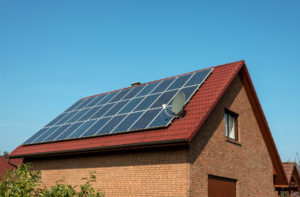As solar panels become increasingly popular, many homeowners wonder if they can take their solar panels with them when they move to a new home. This article will explore the feasibility of moving solar panels, assess the costs, and provide guidance for a smooth transition to a new location.
Contents
- 1 Key Takeaways
- 2 Assessing the Feasibility of Moving Solar Panels
- 3 Evaluating the Cost of Moving Solar Panels
- 4 Consulting a Professional Solar Installation Company
- 5 Assessing the Compatibility of the New Location
- 6 Removing Solar Panels and Preparing for the Move
- 7 Reinstallation of Solar Panels at the New Home
- 8 Considering Alternative Options
- 9 Case Study: Navigating the Challenges of Moving Solar Panels
- 10 Expert Insights From Our Solar Panel Installers About Moving Solar Panels
- 11 Experience Solar Excellence with Us!
- 12 Conclusion
Key Takeaways
- Moving solar panels to a new home is feasible, but its viability depends on factors such as the type of roof, the age of the system, and local regulations.
- Evaluating the cost of moving solar panels is essential, as it includes removal, transportation, and reinstallation expenses.
- Consulting a professional solar installation company is crucial to assess compatibility, ensure proper removal and reinstallation, and explore alternative options.
Assessing the Feasibility of Moving Solar Panels
Before considering moving your solar panels, assessing the feasibility is important based on several factors. The type of roof on your current and new home plays a significant role. If your solar panels are installed on a sloped roof, they are generally easier to remove and reinstall. However, if installed on a flat roof or integrated into the structure, the process might be more complex and require professional assistance. Additionally, the age and condition of your solar panel system should be considered, as older systems may have components that are difficult to find or replace.
Evaluating the Cost of Moving Solar Panels
Moving solar panels involves certain costs that should be taken into account. The cost of removing the panels, including disconnecting the system and ensuring electrical safety, can vary depending on the complexity of the installation. Transportation costs should also be considered, especially if you are moving to a considerable distance. Reinstallation expenses, such as securing the panels to the new roof and reconnecting the system, are additional factors to include in your cost assessment. It is recommended to consult with professional solar installation companies to obtain accurate estimates for your specific situation.
Consulting a Professional Solar Installation Company
To ensure a successful and hassle-free relocation of your solar panels, consulting with a professional solar installation company is crucial. These experts possess the knowledge and experience to assess the compatibility of the new location, evaluate the condition of the solar panels, and provide guidance throughout the moving process. They can also advise you on any local regulations or permits required for the installation in the new area. Engaging professionals will give you peace of mind and increase the likelihood of a seamless transition for your solar panel system.

Assessing the Compatibility of the New Location
Before deciding to move your solar panels, it is essential to assess the compatibility of the new location. Factors such as solar access, shading from nearby structures or trees, and the roof’s condition on your new home are crucial considerations. An optimal location will have good solar exposure throughout the day, allowing your solar panels to generate maximum energy. An expert assessment of the new location will help you determine if it suits your solar system and whether any adjustments or modifications are necessary for optimal performance.
Removing Solar Panels and Preparing for the Move
When relocating solar panels, proper removal and preparation are key to ensuring their safe transport and subsequent reinstallation. It is advisable to work with professionals with experience handling solar panel systems. They will carefully disconnect the panels from the existing electrical system, ensuring the safety of the panels and the personnel involved. Proper labeling and documentation of the removed components will facilitate a smooth reinstallation process at the new location.
Reinstallation of Solar Panels at the New Home
The reinstallation process can begin once your solar panels have been safely transported to the new location. Professionals will assess the new roof, considering its type and condition, and determine the best approach for securing the panels. They will carefully reconnect the electrical components, ensuring proper functionality and compliance with safety standards. Following reinstallation, the system will be thoroughly tested to verify its performance and ensure seamless integration into your new home.
Considering Alternative Options
In some cases, moving solar panels may not be the most practical or cost-effective solution. If the cost of moving your solar panels outweighs the potential benefits, alternative options exist. One option is negotiating a transfer agreement with the new homeowner, allowing them to benefit from the existing solar panel system. Another possibility is to sell the solar panels with your current home, making them an attractive feature for prospective buyers. Exploring these alternatives can help you make an informed decision that aligns with your circumstances.
Background
At Solar Panels Network USA, we often encounter homeowners curious about the feasibility of moving their solar panels when relocating. One such case involved a family moving to a new home several states away, eager to bring their existing solar system along to continue benefiting from renewable energy.
Project Overview
The family’s existing solar panel system was installed on a sloped roof, making it theoretically easier to move. However, the age of the system and the condition of the panels posed potential challenges. Our goal was to assess the feasibility, manage the logistics of removal and reinstallation, and ensure the new location was compatible with the existing system.
Implementation
Assessing Feasibility
The initial step involved a thorough assessment of the current solar panel system. We evaluated the type and condition of the roof, the age and efficiency of the panels, and the overall health of the system’s components. This detailed analysis helped us determine that, while the panels were in good condition, the inverter might need an upgrade due to technological advancements since the original installation.
Cost Evaluation
We provided the homeowners with a comprehensive cost breakdown, including removal, transportation, and reinstallation expenses. By collaborating with our logistics team, we ensured safe transportation of the panels over the long distance. We also factored in the costs of potential upgrades and necessary permits at the new location.
Professional Consultation
Engaging our professional solar installation team was crucial for a smooth transition. We coordinated with local authorities in the new area to understand the regulatory requirements and secured all necessary permits. Our team also inspected the new home’s roof to ensure it provided optimal solar access and could support the relocated panels.
Results
Safe Removal and Transportation
Our experienced team carefully disconnected the solar panels, ensuring all electrical components were safely handled. Proper labeling and documentation of each part facilitated a streamlined reinstallation process. The panels were then transported securely to the new location.
Seamless Reinstallation
Upon arrival, we conducted a thorough inspection of the new roof and determined the best approach for reinstallation. The solar panels were securely mounted, and the electrical components were reconnected and tested for optimal functionality. The inverter was upgraded to enhance system efficiency, aligning with the latest technological standards.
Alternative Considerations
While the move was successful, we also discussed alternative options with the homeowners, such as transferring the system to the new property owner or selling the panels. This ensured they were fully informed and could make the best decision based on cost and practicality.
Summary
This case study highlights the complexities involved in moving solar panels, emphasizing the importance of professional assessment and detailed planning. By carefully evaluating the feasibility, managing the logistics, and ensuring compatibility with the new location, Solar Panels Network USA successfully facilitated the transition, enabling the homeowners to continue enjoying the benefits of their solar energy system. Our expertise ensures that even complex relocations are handled with precision, providing peace of mind and sustained energy efficiency for our clients.
Expert Insights From Our Solar Panel Installers About Moving Solar Panels
Relocating solar panels is indeed feasible, but it’s vital to assess the condition and age of your system. Older panels might pose challenges due to outdated components, making professional evaluation crucial.
Solar Installation Specialist
The type of roof on both your current and new home significantly impacts the complexity of the move. Sloped roofs typically simplify the process, while flat roofs or integrated systems require more specialized handling.
Lead Solar Technician
Consulting a professional is indispensable for a successful move. Experts can ensure that the new location is suitable, handle the removal and reinstallation safely, and navigate any local regulations or permits required.
Senior Solar Energy Consultant
Experience Solar Excellence with Us!
Trust in Solar Panels Network USA, where our seasoned experts deliver top-quality solar solutions for homes and businesses nationwide. With a legacy of countless successful installations and a commitment to sustainable energy, we’re your reliable partner in the solar journey. Ready for a brighter, eco-friendly future? Call us now at (855) 427-0058 and harness the power of the sun!
Conclusion
The possibility of moving solar panels to a new home depends on various factors, including the type of roof, the condition of the panels, and the associated costs. Homeowners can make an informed decision by assessing the feasibility, consulting with professionals, and evaluating the compatibility of the new location. Whether you decide to relocate your solar panels or explore alternative options, the guidance and expertise of solar installation professionals will ensure a smooth transition and maximize the benefits of your solar system.
About the Author
Solar Panels Network USA stands at the forefront of solar energy solutions, driven by a team of seasoned solar engineers and energy consultants. With over decades of experience in delivering high-quality solar installations and maintenance, we are committed to promoting sustainable energy through customer-centric, tailored solutions. Our articles reflect this commitment, crafted collaboratively by experts to provide accurate, up-to-date insights into solar technology, ensuring our readers are well-informed and empowered in their solar energy decisions.

